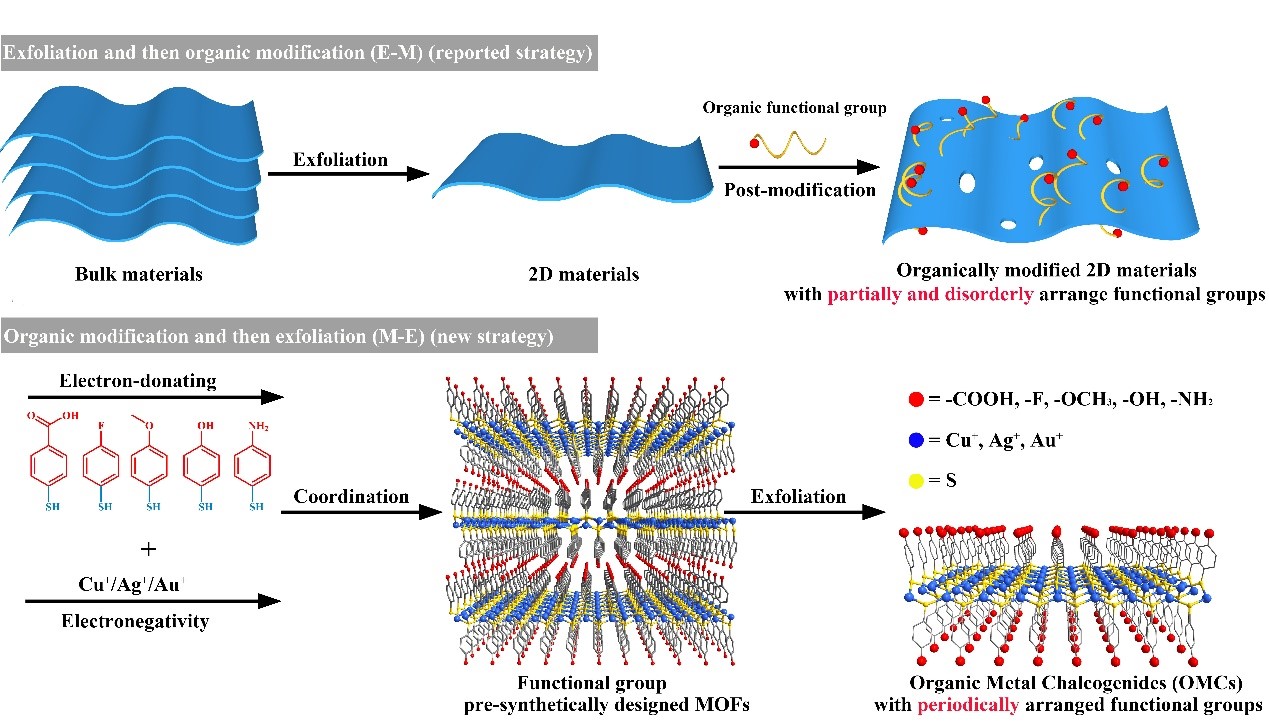
Two-dimensional (2D) materials, which show excellent physical and chemical properties, have received unprecedented attention and become a research hotspot in scientific fields such as physics, chemistry and materials. Organic modification onto 2D materials by covalently bonding or physically adsorbing organic molecules can greatly regulate and optimize the properties of 2D materials.
However, the organic modification methods reported so far are exfoliation first and then organic modification (E-M) strategy, which usually possess some disadvantages such as less modification ratio, uncertain type, number and position of the functional groups, easy to produce defects and so on. Therefore, the development of functionalization of 2D materials is greatly limited.
In a study published in Nature Communications, a research group led by Prof. XU Gang from Fujian Institute of Research on the Structure of Matter (FJIRSM) of the Chinese Academy of Sciences, developed a novel organic modification and then exfoliation (M-E) strategy to prepare 2D organic metal chalcogenide (OMC) materials with tunable band gaps (0.83 eV) and electrical conductivities (9 orders of magnitude).
The researchers conveniently prepared the parent crystals with layered structures deriving OMCs by wet chemistry through the coordination between the metal ion and thiol ligand containing different uncoordinated para-substituted groups. They obtained OMCs by exfoliating their parent crystals into mono- or few-layer nanosheets.
Different from the 2D materials modified by E-M strategy, OMCs prepared by M-E strategy are series of homogeneous inorganic 2D materials with periodically covalent bonding organic functional groups. This structure feature endows wide adjustments in the properties of OMCs by changing the metal centres and organic groups.
OMCs have unique 2D graphene-like inorganic {CuIS}∞, {AgIS}∞ and {AuIS}∞ layer with sandwich modified functional group (–NH2, –OH, –OCH3, –F, or –COOH) which extends out from the inorganic layer. Hence, both surfaces of metal chalcogenide mono-layer are orderly and fully covered by the predesigned functional groups.
Compared with the reported 2D materials by E-M strategy, OMC materials have the advantages of simple preparation, strong system expandability, and functional group designable and so on. OMCs have high thermal stability up to 300 °C, and most of OMCs also showed good chemical stability in pH ranging from 3 to 11 for >12 h.
In addition, band gaps of OMCs can be high flexibility modulated by changing electronegativity of the metal ions or electron-donating ability of organic functional groups. The band gaps of OMCs are totally adjusted by 0.83 eV, which is the highest value reported to date achieved by all chemical methods.
The researchers calculated the thickness-dependent band structure of OMCs by density functional theory showing that OMCs are featured with nearly unchanged band gaps when decreasing layer number from bulk to single layer.
Besides, they found that the conductivity of OMCs can be modulated by changing the electronegativity of metal ions or electron-donating ability of organic functional groups. The conductivity of OMCs can be tuned over 9 orders of magnitude.
This study offers "organic modification first and then exfoliation (M-E) strategy" as an efficient approach for exploring new 2D materials based on coordination self-assembly strategies.

Schematic illustration of the research (Image by Prof. XU's group)

86-10-68597521 (day)
86-10-68597289 (night)

52 Sanlihe Rd., Xicheng District,
Beijing, China (100864)

